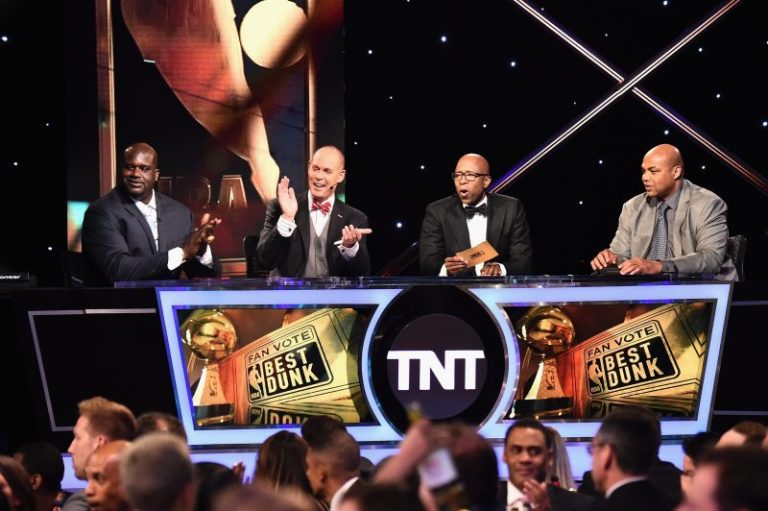After months of speculation about the future format of ‘Inside the NBA,’ ESPN announced on Thursday, Oct. 9 what it called a ‘robust’ schedule for its first NBA regular season airing the long-running show.
‘Inside the NBA’ will air on 20 days during the 2025-26 regular season and serve as a pregame, halftime and postgame show around high-profile games broadcast on ESPN and ABC, part of a new 11-year rights agreement with the NBA beginning this year. The 21-time Emmy Award winning studio show featuring host Ernie Johnson and analysts Charles Barkley, Kenny Smith and Shaquille O’Neal will make its ESPN debut with a one-hour pregame show from 6-7 p.m. ET on Oct. 22 ahead of the network’s doubleheader featuring the New York Knicks vs. Cleveland Cavaliers and San Antonio Spurs vs. Dallas Mavericks.
But there remains a mixture of unease, concern and anticipation about the partnership, and how it could affect ‘Inside the NBA,’ with Barkley frequently voicing skepticism over the past year about whether the show can keep its free-wheeling style under constraints presented by ESPN and its usage of ‘SportsCenter’ as a postgame anchor for primetime games.
Here’s a breakdown of the ‘Inside the NBA’ schedule for the 2025-26 NBA season, as well as what to know about the show’s new arrangement with ESPN and TNT:
ESPN ‘Inside the NBA’ regular season schedule
‘Inside the NBA’ is scheduled to air on ESPN or ABC at least 20 days during the 2025-26 NBA regular season, including the league’s Christmas Day games and every Saturday night primetime game aired on ABC beginning Jan. 24. It will serve as a pregame, halftime and postgame show for the NBA games broadcast by ABC or ESPN on the days it airs.
There is only one announced episode after March 14 due to Barkley, Smith and Johnson being involved with Turner Sports’ March Madness coverage. But the show is slated to air on ESPN and ABC throughout the NBA Playoffs, including the Eastern Conference Finals and the NBA Finals, with dates to be announced later in the season. Here’s the full regular-season schedule:
Wednesday, Oct. 22
Thursday, Oct. 23
Wednesday, Oct. 29
Wednesday, Nov. 12
Thursday, Dec. 25
Saturday, Jan. 24
Wednesday, Jan. 28
Saturday, Jan. 31
Saturday, Feb. 7
Friday, Feb. 20
Saturday, Feb. 21
Sunday, Feb. 22
Friday, Feb. 27
Saturday, Feb. 28
Sunday, March 1
Friday, March 6
Saturday, March 7
Sunday, March 8
Saturday, March 14
Sunday, April 12
Inside the NBA format on ESPN, ABC
‘Inside the NBA’ pregame shows on ESPN will begin one hour before tipoff, with postgame shows starting immediately after the game ends. Pregame shows on ABC will begin 30 minutes prior to tipoff. Saturday primetime games on ABC will also have a postgame show starting immediately after the game ends that will continue on the ESPN app. ‘Inside the NBA’ is also the pregame show for the NBA Sunday Showcase series on ABC.
‘We’re proud that ‘Inside the NBA’ – one of the most iconic and beloved shows in all of media – will play a leading role in our NBA coverage,’ ESPN president of content Burke Magnus said in a statement on Thursday, Oct. 9. ‘Fans should expect the same great show they’re accustomed to watching as it becomes an essential part of the highest-profile events in the NBA, including the NBA Finals.’
The show will still be produced by TNT from Atlanta during the regular season. Disney, which owns ABC and ESPN, agreed to a sub-licensing deal with Warner Bros. Discovery, the parent company of TNT, as part of a settlement when Warner Bros. Discovery sued the NBA in August 2024 after its offer for one of the league’s new 11-year media rights deal was not accepted.
Charles Barkley’s concerns about ‘Inside the NBA’ future
Barkley didn’t like the way TNT handled its negotiations with the NBA or how it kept the cast and crew of ‘Inside the NBA’ in the dark about its impending partnership with ESPN. The former NBA star has also been very open about his concerns that the show will have to change its signature style under the auspices of a new network.
‘I’m happy it’s going on but it’s going to be interesting,’ Barkley said in July. ‘It’s going to be different, but you know that’s the bad thing about it. We don’t know how it’s going to be different.’
As recently as last month, during an interview on ‘The Bill Simmons Podcast,’ Barkley said he still wasn’t sure if he, Johnson, Smith and O’Neal would be permitted to do longer segments during postgames shows as they often did late-night on TNT over the years. ‘Are we going to get any time or are they going to say, you have to go straight to ‘SportsCenter’?’ Barkley openly wondered.
ESPN’s announcement on Thursday tried to answer those questions. A definitive one will arrive starting in less than two weeks, when ‘Inside the NBA’ officially begins this new chapter.










